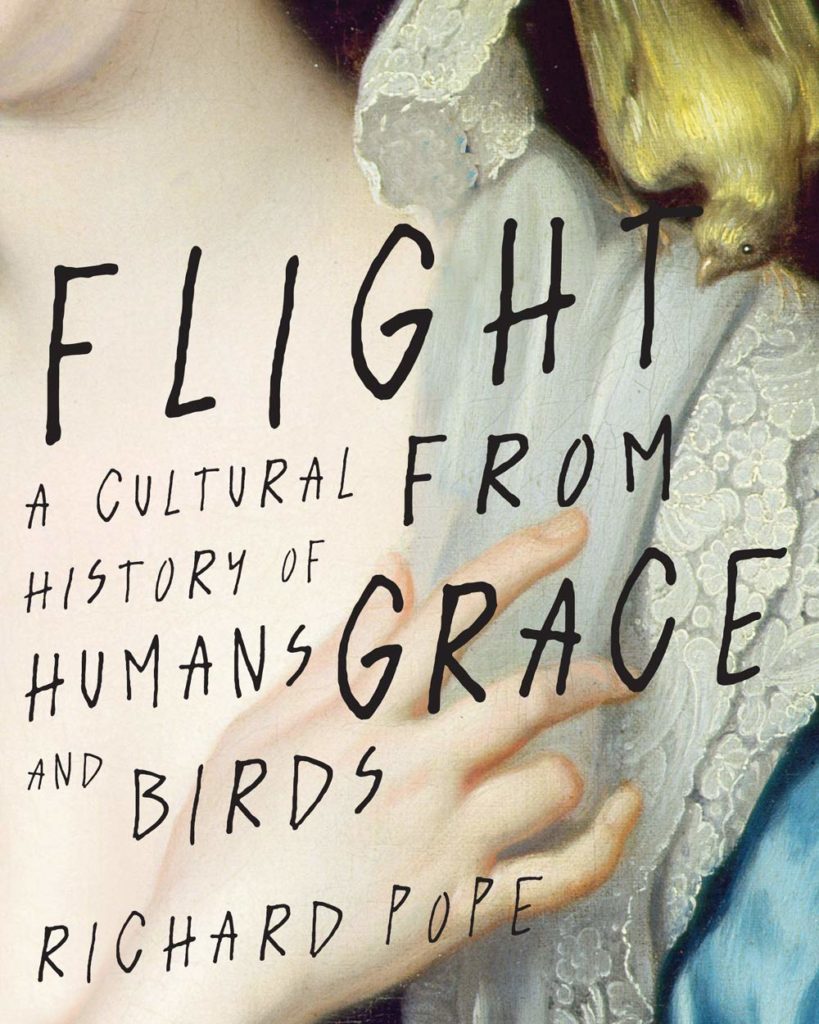Here is an excerpt from Richard Pope’s intriguing new book about man’s long fascination with birds and flight. It’s called, Flight from Grace, and the little sample that follows wonderfully demonstrates the genius of early man. The book takes wing immediately with little-known facts, supplemented by astonishing images of artifacts that stand testament to the human spirit.
Portable art, which includes carvings, figurines, and engravings on ivory, stone, bone, and antler, is found often, but not exclusively, in caves. Bird representations are not uncommon in this art, particularly in the Magdalenian period (15,000–10,000 BCE). In French Palaeolithic art alone, out of 121 possible bird representations, Dominique Buisson and Geneviève Pinçon accept 81 as certain. Of these 81 sure bird representations, 15 (19 per cent) are on cave walls and 67 (81 per cent) are portable. Birds are much more common in portable art everywhere during the Palaeolithic. It is also striking that of the 81 sure French birds, almost half of which are not identifiable to species (47.6 per cent), 37 per cent represent either web-footed birds like ducks, geese, and swans or crane-like waders, and 10 per cent are raptors. The popularity of these waterbirds and raptors is also attested throughout Palaeolithic bird art in general. R. Dale Guthrie is right to point out that not all of these representations are masterpieces. Often carved in difficult materials, they range from the relatively crude to the superb. The artistic quality of these birds would not, however, have affected their function as amulets, pendants, charms, and ex-votos.
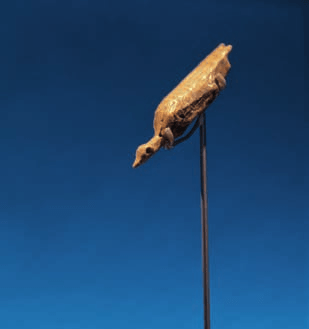
At the mention of mammoth-ivory sculpture of the Palaeolithic, one’s first thought is of the numerous figurines of plump females – the so-called Palaeolithic Venuses – found from Spain right across to Lake Baikal in eastern Siberia. What is interesting for us, however, is the common association of these Venuses with carvings of birds. Although these early Venuses are never bird-headed, as they often are in the Neolithic, these cult objects are often found in association with bird figurines and pendants. The Palaeolithic Venuses are thought by many to be figures with cult significance, and I believe that the bird figurines generally reflect the same cult status and represent various early forms of bird worship.
Perhaps our oldest known bird sculpture, dating from at least 28,000 BCE, is a mammoth-ivory carving found in the Hohle Fels Cave in the Swabian Jura mountain range in Germany – a charming representation of a flying waterbird, thought by some (not birders, I suspect) to be a cormorant but almost certainly some kind of duck. You can even see the feathers carved on the bird’s side. The only representation of a bird that is older is the Chauvet engraved owl and perhaps a partridge/quail engraving on a flint flake, discussed below.
Before considering this bird’s significance, it is interesting to note what else was found in the Hohle Fels Cave in the period dating from before or around 30,000 BCE. There is an ivory Löwenmensch similar to, although less exquisite and smaller than, the famous one found in the Stadel Cave, which is known to date from about 38,000 BCE. Significantly, these Löwenmensch figurines are not carvings of humans wearing lion masks but of human figures with lion heads. They are monstrous hybrids that could exist only in the human imagination but must have been part of the local belief structure, as we can deduce from the fact that we have two such figurines from two different caves in the Swabian Jura, where one of the earliest settlements of human beings in Europe took place. Our oldest Palaeolithic Venus, possibly a pendant, was unearthed here in 2008 and found to be at least 37,000 years old; fragments of a second one were discovered in 2015. Although it seems slightly younger, dating from about 26,000 BCE, we also have a carved stone phallus measuring nearly 8 inches (20 centimetres), almost certainly associated with some kind of ritual or ceremony concerning procreation and fertility, as are the Palaeolithic Venuses. A stunning find was a fivehole flute made from the wing bone of a griffon vulture dating from about 33,000 BCE – an object suggestive of the dance floor, which is so closely connected to the origins of the sacred. Lastly, dating from about 28,000 BCE, there is a carving of the head of a horse, notably not a major food item for these humans, that is reminiscent of the horses in cave wall art. Clearly, this cave was some kind of sanctuary where religious beliefs were manifested. So, although we can never know the meaning of any Palaeolithic work of art for certain, the fact that the bird carving was found in the same cave as carvings of naked women, a Löwenmensch, a phallus, a horse, and a flute suggests that something more than art classes was taking place in this early cave and that our bird very likely had some kind of cult importance in the belief structure of these early humans.
We also have a number of exquisite flying-bird pendants (and three that are not flying) from the incredible Mal’ta site in Siberia northwest of Lake Baikal, excavated by the Russian archaeologist Mikhail Mikhaylovich Gerasimov. Most of them were found in connection with hearths, and cult status is nearly certain. Several of them were found in the famous grave of a four-year-old child, the same child who clinched the genetic link between the Mal’ta-Buret’ people and North American Indigenous peoples. These mammoth-ivory flying-bird pendants were originally thought to date from 23,000–19,000 BCE, although more recent radiocarbon dating has suggested a somewhat later Magdalenian date around 15,000 BCE.
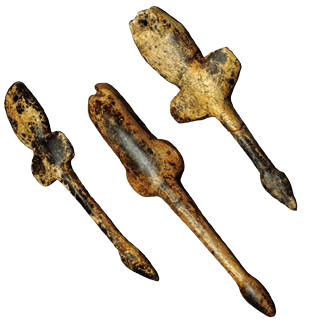
Most of the Mal’ta bird figurines represent flying waterfowl, probably swans judging by the long necks. Thirteen of them are very similar in shape and are both phallic and snakelike in form, suggesting connections between the bird deity and two other potent symbols of the sacred.
In western Europe, echoing Mal’ta, we again find representations of waterfowl: a carving of waterfowl with young at the Mas d’Azil Cave, a swan engraved on stone at the Gourdan Cave and one at the Teyjat Cave, a duck/goose engraved on horn at Gourdan and one at the Caves of Nerja, and a duck engraved on stone at the Cave of Espélugues in Lourdes. Michèle Crémades and colleagues illustrate several ducks from the Parapalló and Escabasses Caves and geese from the Labastide and Gourdan Caves.
Waterbirds, such as grebes, loons, ducks, geese, and swans, were sacred to subsistence-hunting peoples in the Palaeolithic and still revered in the Neolithic and historic periods. Diving birds, like the zhingibis (grebe and the maang (loon), still play an important role to this day in Ojibwe trickster stories and creation legends, as well as in the Ojibwe clan system, where we find Crane, Loon, Black Duck, and Goose among the totems. You might well ask, why diving birds? But think about it: grebes, loons, and diving ducks are perhaps the only creatures that are at home in the murky depths of lakes and rivers, nest on dry land, and are at home in the sky, being strong migratory fliers. The ability to survive in all three elements makes them obvious candidates for magical status.
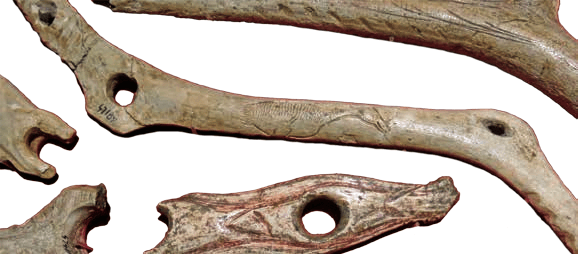
Equally important, ducks, geese, swans, and cranes are markers of the retreat and reappearance of winter; they are among the last to leave in autumn and the first to arrive in spring. Migration must have been very mysterious and seemed magical, like eclipses and solstices; birds, the sun, and the seasons disappear and then, hopefully, reappear – a source of major anxiety. Wherever did these mysterious beings go? What if they did not reappear? Hence the reverence for waterbirds, the sun, and the spring, along with the need to devise rituals in order to ensure their return. And last but not least, ducks, geese, and swans were a crucial food source for the people who hunted them, collected their eggs, and reaped them in great numbers during the flightless period of the moult. It is natural to revere fellow creatures that you rely on for food. These are birds you would not want to offend lest they abandon you. Perhaps indicative of their power is the touching, late-Neolithic burial at Vedbaek in Denmark of a tiny baby boy next to its young mother, the baby cradled in a whooper swan’s wing. The swan may have been meant to escort the child to the other world.
It is interesting to note that this waterfowl cult persisted in various societies throughout the Neolithic until modern times. In Russia and Siberia, Margarita Aleksandrovna Kiriyak tells us, “[b]irds are a widespread subject of rock drawings in the Neolithic art of north Eurasian tribes. Both waterfowl and birds of prey are encountered among the images.” There are also many carvings. She provides us with a photograph of a beautifully carved, upright goose made of smoky obsidian that is sitting with its neck stretched up, found at the Neolithic Tytyl’ IV site in western Chukhotka. Joseph Campbell points out that “early Russian missionaries and voyagers in Siberia … found among the tribes numerous images of geese with extended wings.” Steven Mithin reminds us that, “[a]mong the nineteenth-century Saami people of northern Europe, swans and waterfowl were the messengers of the gods.” The Canadian High Arctic was peopled by immigrants from Siberia, so we are not surprised to find Palaeo-Eskimo carvings of birds, such as waterbirds, cranes, and falcons, like the carvings of the Dorset (Tuniit) culture (500 BCE–ca. 1200 CE), which long preceded the later Inuit culture. Coastal-dwelling peoples who made their living from the sea revered the seabirds, which were so crucial to their existence. Newfoundland’s Beothuks, for example, appear to have had such “birds at the centre of their belief system.” Beothuks were buried in seaside graves with the feet of actual birds – guillemots – attached to their leggings and with various carved and engraved ivory and bone pendants, of which over 400 have been found, all plausibly identified as representing seabirds’ feet, seabirds’ primary wing feathers, or the tails of Arctic terns in flight. Since one equips the dead with precisely those items needed for the journey to the afterlife, which in this case entailed flight over water to an island paradise, these birds were doubtless crucial helpers serving in their classic role as psychopomps.
In his Folklore of Birds (1958), Edward Armstrong devotes three whole chapters to the ubiquitous cult of waterfowl – geese, swans, and loons in particular – that survives in later, worldwide folklore. This was a tenacious tradition!
Among the long-legged waders, cranes are well attested in Palaeolithic art. Jean-Jacques Cleyet-Merle and Stéphane Madelaine, after careful study of a Magdalenian engraving on a perforated stick of reindeer antler from Laugerie-Basse in the Dordogne region, convincingly established that the engraved wader was a common crane by cleverly fitting two separate pieces back together. They say that there is a striking similarity between this bird and the two engraved on the piece of schist found in the Labastide Cave, which they take to be cranes as well. Crémades and colleagues illustrate a crane-like wader found in the Gargas Cave in the Pyrenees and add three recently discovered engraved cranes, one on a spear point, from Magdalenian sites in the Pyrenees. In the Belvis Cave, there is an engraving on bone of a very odd, horizontal wading bird – longnecked like a crane or heron. In the Morín Cave, there is an engraving on a rib fragment of what appear to be five overlapping bird heads; although Don Hitchcock thinks that they are ducks or swans, I think that they look more like large, long-billed waders – cranes or herons. In any case, this edible, upright, dancing bird, which marked off the seasons by its migration, was obviously very special for early modern humans. It is not surprising, then, that among the special dances performed in ancient Greek sanctuaries was the Crane Dance, performed “with tortuous, labyrinthian movements.”
After the owls in the Chauvet and Trois Fréres Caves, it will come as no surprise that owls figure in Palaeolithic portable art as well. We have at least four very old owl representations dating from about 25,000 BCE at the sites of Dolní Věstonice and Pavlov in Moravia in the Czech Republic. Two are owl pendants, which were probably worn either for clan reasons or as amulets offering protection by a deity, just as one might wear a Saint Christopher medal or a cross around one’s neck today or hang a Magnetic Mary in the car. The other two are baked-clay figurines of owls, neither of which are earless, making them perhaps Eurasian eagle-owls. There is also an Upper Palaeolithic owl carved from an animal tooth that was found in the Mas d’Azil Cave, which is quite similar to the Dolní Věstonice figurines. Lastly, we have a handle of some sort with a carved face of an owl found at the Russian site of Avdeevo dating from about 19,000–18,000 BCE.
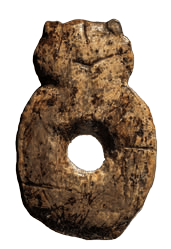
Waterbirds and owls do not exhaust our list of birds in Palaeolithic portable art. In Mezin, a Magdalenian settlement near Kiev, six little mammoth-ivory figurines of birds were found dating from about 15,000– 13,000 BCE. They are beautifully and delicately carved with fat bodies and flat tails and incised with delicate patterns of lines presenting our earliest known example of the meander pattern. Some are flying birds and some are not, and none of them seem to be waterfowl. They appear to represent plump, edible birds, and judging by their fat bodies and longish, flat tails, my best guess is that they represent some kind of a grouse, partridge, or ptarmigan. They are linked to the goddess motif by the etched pubic triangles – vulva symbols – on their backs.
Ptarmigan will continue to be an important theme in art when we move into the Neolithic. In far northeastern Russia in Chukhotka, among the many small stone bird carvings, we find a number of ptarmigan.
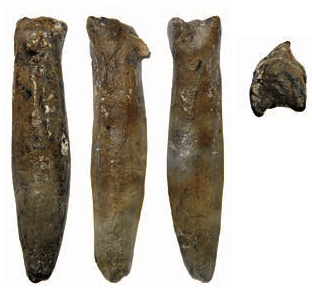
It is noteworthy that grouse and ptarmigan were also revered in western Europe. There is a detailed carving of a grouse, with the head missing, on the end of an atlatl, or spear-thrower, made of antler that was found in Mas d’Azil. The Gönnersdorf Cave, an Upper Palaeolithic site on the Middle Rhine with over 150 engravings of animals on slate, also has a few lifelike bird engravings from around 15,000 BCE, one of which is a ptarmigan. A bird that Armstrong, probably rightly, takes to be a ptarmigan engraved on a reindeer antler was found in the Isturitz Cave. There is an engraving on a limestone pebble from Laugerie-Basse that is either a corvid – scavenging bird – or a capercaillie.
There is a bird engraved using the sunken relief method on a flint flake found at the open-air site Cantalouette II in the Dordogne region. It is interesting because of the sunken relief technique and its Aurignacian origins (33,000–29,000 BCE). It is one of our oldest pieces of Palaeolithic bird art – along with the Hohle Fels waterbird and the Chauvet owl – and it may be a grey partridge or a common quail.
The grouse/ptarmigan can hardly have been a fortuitous choice for carvers; to assume that it is just a pretty design is an anachronistic assumption. Upper Palaeolithic and Neolithic artists did not work that way; this crucial winter food source was probably chosen for clan and totem reasons or because the carvings were seen as fetishes and carried with one to please and appease the grouse spirit. These carvings were not baubles.
There seem to be few Palaeolithic representations of birds other than waterbirds, birds of prey, namely owls, and birds of the grouse type in our early portable art. There is a bird pendant carved from a cave bear’s canine tooth that was found in the Solutrean layer (20,000–15,000 BCE) of the Buxu Cave in Spain. It is thought to be some kind of crake or other member of the Rallidae family, although that is doubtful. There are a few bustards, like the two from the Gourdan Cave, one from Laugerie-Basse, and one from Abri de la Madeleine, although they can be hard to tell from geese. There is a bird, together with a bison, engraved on sandstone in the Cave of Puy-de-Lacan, and it is usually thought to be a long-legged duck or goose, although it is much more likely a bustard. Apart from these edible birds, there are hardly any others.
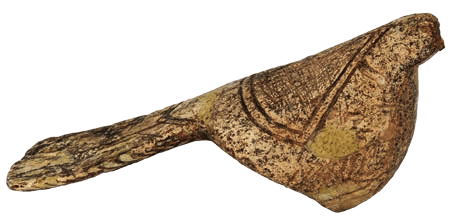
The great tradition of Palaeolithic art came to an end around 9500 BCE after at least 25,000 years, “perhaps the greatest art tradition humankind has ever known.” The uniformity of subjects and techniques over so long a period is astounding.
What we see in these bird drawings, figurines, pendants, and engravings is a 20,000-year continuum of representations of various birds that demonstrates the persistence of the bird as cult object and sacred amulet throughout the Palaeolithic. It is not accidental that birds, snakes, Venuses, and penises turn up so regularly in this animistic culture, where humans need all the help that they can get to survive. It will not be surprising if earlier finds from the Middle Palaeolithic (298,000–48,000 BCE) turn up, and if they do, we can bet that among them there will be birds.
As we prepare with regret to leave the Palaeolithic and enter the Pre-Pottery Neolithic (10,000–6500 BCE), what can we conclude about the role of birds in human eyes up to this time? Any thought that birds were just pretty or edible creatures that could serve as the subjects of objets d’art must be banished. As Armstrong puts it, “to man in the Old Stone Age [or Palaeolithic] birds were not merely acceptable as food but symbolized mysterious powers which pervaded the wilderness in which he hungered, hunted and wove strange dreams.” Birds, in various forms, from diving birds to owls and grouse, were sacred and thought to have spirits whose help was sought for coping with life and death. Birds were carved from mammoth ivory, bone, antler, and stone, depicted on atlatls, worn on the body as pendants, buried in the grave with children, carried as fetishes, or simply kept as cult representations deep in caves, where they were painted or etched on the walls of inner sanctum rooms in positions of honour that reflected the degree of sacredness imputed to these feathered deities. From our earliest Upper Palaeolithic finds at Hohle Fels and Chauvet to our youngest ones at Lascaux and Mas d’Azil, the importance of birds for humans remains paramount.
The featured image shows, “Margaret (‘Peg’) Woffington (the actress),” by Jean-Baptiste van Loo, painted ca. 1738.

